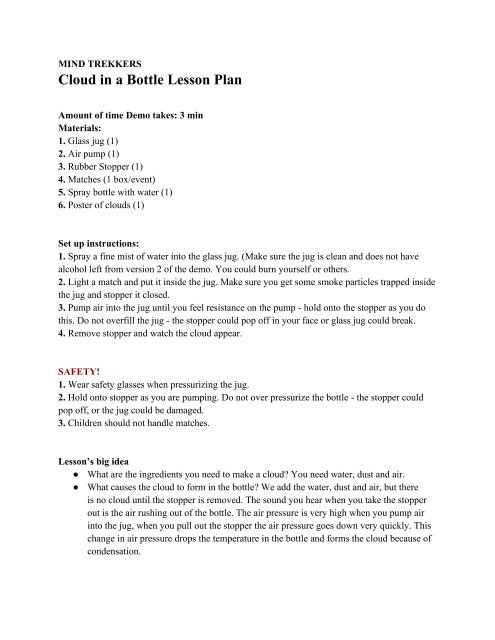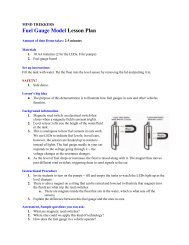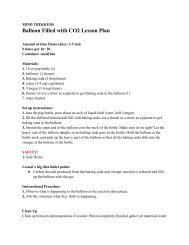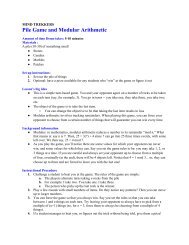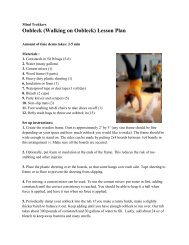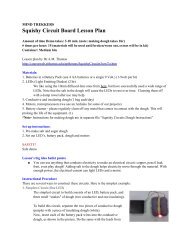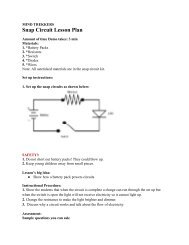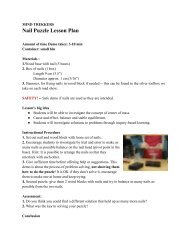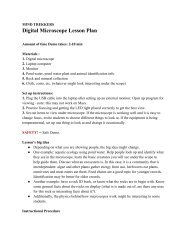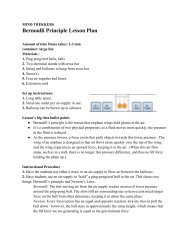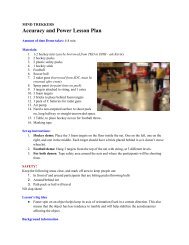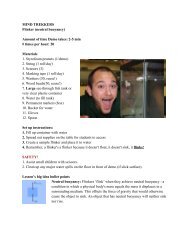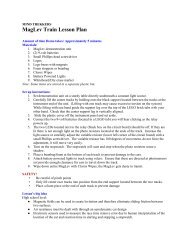Cloud in a Bottle Lesson Plan - MTU Mind Trekkers
Cloud in a Bottle Lesson Plan - MTU Mind Trekkers
Cloud in a Bottle Lesson Plan - MTU Mind Trekkers
Create successful ePaper yourself
Turn your PDF publications into a flip-book with our unique Google optimized e-Paper software.
MIND TREKKERS<br />
<strong>Cloud</strong> <strong>in</strong> a <strong>Bottle</strong> <strong>Lesson</strong> <strong>Plan</strong><br />
Amount of time Demo takes: 3 m<strong>in</strong><br />
Materials:<br />
1. Glass jug (1)<br />
2. Air pump (1)<br />
3. Rubber Stopper (1)<br />
4. Matches (1 box/event)<br />
5. Spray bottle with water (1)<br />
6. Poster of clouds (1)<br />
Set up <strong>in</strong>structions:<br />
1. Spray a f<strong>in</strong>e mist of water <strong>in</strong>to the glass jug. (Make sure the jug is clean and does not have<br />
alcohol left from version 2 of the demo. You could burn yourself or others.<br />
2. Light a match and put it <strong>in</strong>side the jug. Make sure you get some smoke particles trapped <strong>in</strong>side<br />
the jug and stopper it closed.<br />
3. Pump air <strong>in</strong>to the jug until you feel resistance on the pump - hold onto the stopper as you do<br />
this. Do not overfill the jug - the stopper could pop off <strong>in</strong> your face or glass jug could break.<br />
4. Remove stopper and watch the cloud appear.<br />
SAFETY!<br />
1. Wear safety glasses when pressuriz<strong>in</strong>g the jug.<br />
2. Hold onto stopper as you are pump<strong>in</strong>g. Do not over pressurize the bottle - the stopper could<br />
pop off, or the jug could be damaged.<br />
3. Children should not handle matches.<br />
<strong>Lesson</strong>’s big idea<br />
● What are the <strong>in</strong>gredients you need to make a cloud You need water, dust and air.<br />
● What causes the cloud to form <strong>in</strong> the bottle We add the water, dust and air, but there<br />
is no cloud until the stopper is removed. The sound you hear when you take the stopper<br />
out is the air rush<strong>in</strong>g out of the bottle. The air pressure is very high when you pump air<br />
<strong>in</strong>to the jug, when you pull out the stopper the air pressure goes down very quickly. This<br />
change <strong>in</strong> air pressure drops the temperature <strong>in</strong> the bottle and forms the cloud because of<br />
condensation.
●<br />
●<br />
●<br />
If you pump air back <strong>in</strong>to the cloud filled bottle, the cloud will disappear as the<br />
temperature <strong>in</strong>creases, when released the cloud will reappear.<br />
High pressure : clear skies and clear bottle<br />
Low pressure : cloudy skies and a cloud <strong>in</strong> the bottle<br />
Instructional Procedure<br />
1. Follow the set-up <strong>in</strong>structions. You may be able to make a cloud from the same <strong>in</strong>gredients a<br />
few times <strong>in</strong> a row to show people you are demonstrat<strong>in</strong>g it to by pump<strong>in</strong>g <strong>in</strong> air and releas<strong>in</strong>g<br />
the stopper.<br />
2. Discuss the <strong>in</strong>gredients for a cloud, and how clouds form. Use examples they may be familiar<br />
with, like see<strong>in</strong>g their breath on a cold day. Hot moist air hits cold dry air, and a cloud forms<br />
from your breath.<br />
● Even though we don't see them, water molecules are <strong>in</strong> the air all around us. These airborne water<br />
molecules are called water vapor. When the molecules are bounc<strong>in</strong>g around <strong>in</strong> the atmosphere,<br />
they don't normally stick together. Pump<strong>in</strong>g the bottle forces the molecules to squeeze together<br />
or compress. Releas<strong>in</strong>g the pressure allows the air to expand, and <strong>in</strong> do<strong>in</strong>g so, the temperature<br />
of the air becomes cooler. This cool<strong>in</strong>g process allows the molecules to stick together - or<br />
condense - more easily, form<strong>in</strong>g t<strong>in</strong>y droplets. <strong>Cloud</strong>s are noth<strong>in</strong>g more than groups of t<strong>in</strong>y<br />
water droplets! The reason the rubb<strong>in</strong>g alcohol forms a more visible cloud is because alcohol<br />
evaporates more quickly than water. Alcohol molecules have weaker bonds than water molecules,<br />
so they let go of each other more easily. S<strong>in</strong>ce there are more evaporated alcohol molecules <strong>in</strong><br />
the bottle, there are also more molecules able to condense. <strong>Cloud</strong>s on Earth form when warm air<br />
rises and its pressure is reduced. The air expands and cools, and clouds form as the temperature<br />
drops below the dew po<strong>in</strong>t. Invisible particles <strong>in</strong> the air <strong>in</strong> the form of pollution, smoke, dust or<br />
even t<strong>in</strong>y particles of dirt help form a nucleus on which the water molecules can attach. http://<br />
www.stevespanglerscience.com/experiment/cloud-<strong>in</strong>-a-bottle-experiment<br />
●<br />
<strong>Cloud</strong>s generally form when ris<strong>in</strong>g air is cooled to its dew po<strong>in</strong>t, the temperature at which the air<br />
becomes saturated.[3] Water vapour normally beg<strong>in</strong>s to condense on condensation nuclei such as<br />
dust, ice, and salt <strong>in</strong> order to form clouds. Condensation at surface level results <strong>in</strong> the formation<br />
of fog. If sufficient condensation particles are not present, the air will become supersaturated and<br />
the formation of cloud or fog will be <strong>in</strong>hibited. There are four ma<strong>in</strong> mechanisms for cool<strong>in</strong>g the<br />
air to its dew po<strong>in</strong>t: adiabatic cool<strong>in</strong>g which tends to produce cloud, and conductive, radiational,<br />
and evaporative cool<strong>in</strong>g that can result <strong>in</strong> the formation of fog. Adiabatic cool<strong>in</strong>g occurs when<br />
air rises and expands.[4] The air can rise due to convection, large-scale atmospheric lift along<br />
weather fronts and around centres of low pressure, or as a result of be<strong>in</strong>g forced over a physical<br />
barrier such as a mounta<strong>in</strong>(orographic lift).[5] Conductive cool<strong>in</strong>g occurs when the air comes <strong>in</strong>to<br />
contact with a colder surface,[6] usually by be<strong>in</strong>g blown from one surface to another, for example<br />
from a liquid water surface to colder land. Radiational cool<strong>in</strong>g occurs due to the emission of<br />
<strong>in</strong>frared radiation, either by the air or by the surface underneath.[7] Evaporative cool<strong>in</strong>g occurs<br />
when moisture is added to the air through evaporation, which forces the air temperature to cool to<br />
itswet-bulb temperature, or until it reaches saturation.[8] http://en.wikipedia.org/wiki/<strong>Cloud</strong>
3. Show the cloud poster and discuss cloud types, if outside you can help them identify the types<br />
of clouds <strong>in</strong> the air. Different types of weather, w<strong>in</strong>d, air pressure, temperatures form different<br />
types of clouds.
Assessment:<br />
1. What <strong>in</strong>gredients do you need to make a cloud (water vapor, dust particles, change <strong>in</strong> air<br />
pressure)<br />
2. What is the sound you hear when the stopper is removed (the air rush<strong>in</strong>g out)<br />
3. High pressure equals what k<strong>in</strong>d of sky Low pressure equals what k<strong>in</strong>d of sky (clear, cloudy)<br />
Clean Up
Clean up between demonstrations if needed. When completely f<strong>in</strong>ished gather all materials listed<br />
for this demonstration and make sure everyth<strong>in</strong>g is accounted for. If someth<strong>in</strong>g was used up,<br />
broken or damaged. Let someone know so it can get replaced or fixed.<br />
Clean out the bottle, get all the matches out. Do not put matches down the dra<strong>in</strong>.<br />
References:<br />
http://en.wikipedia.org/wiki/<strong>Cloud</strong><br />
http://www.stevespanglerscience.com/experiment/cloud-<strong>in</strong>-a-bottle-experiment<br />
http://web.gccaz.edu/~lnewman/gph111/topic_units/Pressure_w<strong>in</strong>ds/pressure/pressure2.html<br />
National Standards:<br />
K-4 Content Standard D, Earth and Space Science, Objects <strong>in</strong> the sky<br />
5-8 Content Standard D, Earth and Space Science, Structure of the earth system<br />
9-12 Content Standard D, Earth and Space Science, Energy <strong>in</strong> the earth system


